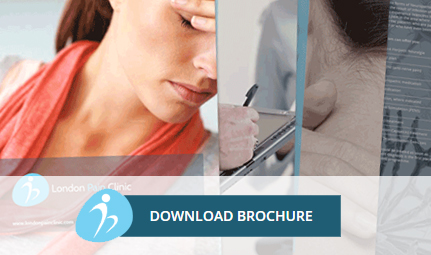Here at the London Pain Clinic, our Pain Consultants are all too aware that lower back pain often occurs alongside comorbidities (that is to say, other health disorders). These include:
- Musculoskeletal disorders (such as rheumatoid arthritis and osteoarthritis)
- Cerebrovascular and cardiovascular conditions, and
- Diseases such as hypertension and lipid metabolism disorders
- Moreover, many of those suffering from long-term low back pain also experience depression, anxiety, and other psychological issues [1, 2]
Putting a Spotlight on Low Back Pain
Low back pain (LBP) impacts the lumbar region the back /spine. This scenario can be due to certain conditions or injuries. Furthermore, it is important to note here, that inline with lower back pain research, our world-class Pain Consultants regularly see that the main cause of patients’ LBP is down to injured muscles or tendons.
Did you know that: “Up to 23% of adults worldwide have chronic lower back pain. In some cases, lower back pain can make it difficult or impossible to walk, sleep, work or do everyday activities. Given how common it is, it may be hard to tell if you should be worried about your lower back pain” [1], so the best advise is to book an online or in-person consultation with a Pain Doctor if you have been experiencing lower back pain for an extended period of time (over two weeks), or if your lower back is causing you harsh pain. Moreover, it is important to bear in mind that LBP can have an adverse knock-on effect on your general health and well-being, and if left untreated, your condition can get worse.
Getting Your Life Back on Track
After one of our Pain Specialists has given you an accurate diagnosis and determined the cause of your lower back pain, they will then devise a Holistic Personalised Treatment Plan. This is likely to include multiple treatments including conventional, and the latest state-of-the-art treatments, therapies and injectables (including pain blockers and Botox).
LBP Causes & Symptoms to Look Out For
Lower back pain can:
- Appear slowly, or come on suddenly
- Feel achy, dull or sharp
- Occur after a particular event (such as lifting something heavy). Note: you could hear a ‘popping’ sound when it happens
- Be due to an unknown trigger
- Be persistent, or come and go
- Extend down your buttock and the back of your leg via the sciatic nerve (a condition known as sciatica)
- Feel worse when you are in specific positions (such as crouching down or bending over), and ameliorate when you are lying down [1]
Other symptoms of LBP comprise:
- Stiffness: sufferers may find it difficult to straighten or move their back
- It could take a while to be able to stand up from a seated position, and sufferers may feel as though they need to stretch or walk in order to loosen up
- A decreased range of motion
- Postural issues: our Pain Doctors see that a large percentage of individuals with LBP find it difficult to stand up straight. To that end, some patients stand in a bent or ‘crooked’ way, and hold their torso to the side rather than maintaining alignment [1]
References
[1]. Cleveland Clinic (2025). “Lower Back Pain.”
https://my.clevelandclinic.org/health/diseases/7936-lower-back-pain
[1]. Gore M, Sadosky A, Stacey BR, Tai KS, Leslie D. The burden of chronic low back pain: clinical comorbidities, treatment patterns, and health care costs in usual care settings. Spine (Phila Pa 1976). As cited by the NIH.
[2]. Schneider et al. Comorbidity of low back pain: Representative outcomes of a national health study in the Federal Republic of Germany, European Journal of Pain, Volume 11, Issue 4, 2007,
Pages 387-397. As cited by Science Direct.



